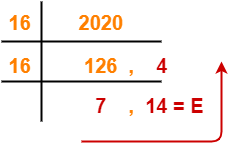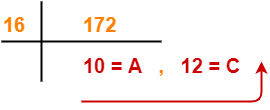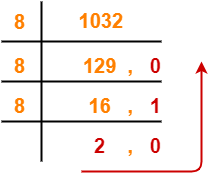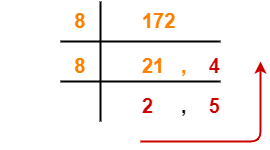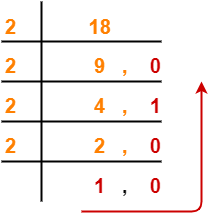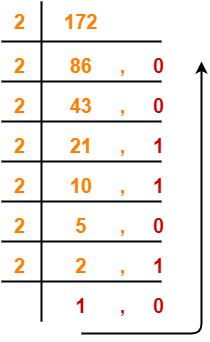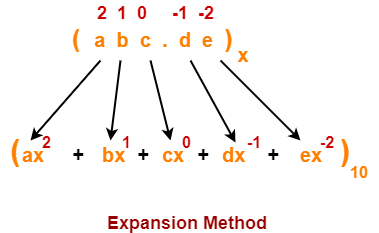Number System Conversions-
Before you go through this article, make sure that you have gone through the previous article on Basics of Number System.
In number system,
- It is very important to have a good knowledge of how to convert numbers from one base to another base.
- Here, we will learn how to convert any given number from any base to any other base.

Conversion of Bases-
A given number in base x can be converted to any other base y using the following steps-
Step-01:
Convert the number from base x to base 10 using expansion method.
Read More- Conversion to Base 10
Step-02:
Convert the number from base 10 to base y using division & multiplication method.
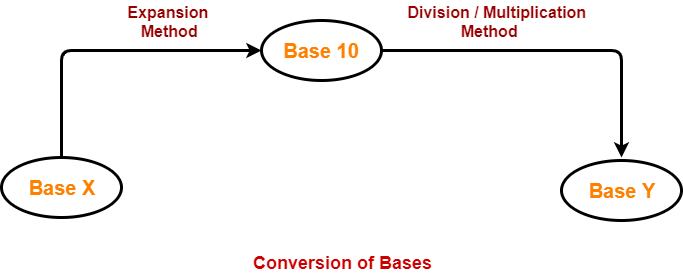
Read More-
PRACTICE PROBLEMS BASED ON CONVERSION OF BASES-
Problem-01:
Convert (1056)16 to ( ? )8
Solution-
Step-01: Conversion To Base 10-
(1056)16 → ( ? )10
Using Expansion method, we have-
(1056)16
= 1 x 163 + 0 x 162 + 5 x 161 + 6 x 160
= 4096 + 0 + 80 + 6
= (4182)10
From here, (1056)16 = (4182)10
Step-02: Conversion To Base 8-
(4182)10 → ( ? )8
Using Division method, we have-
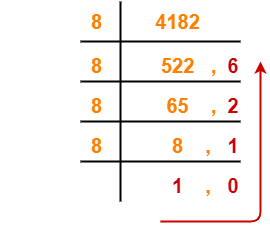
From here, (4182)10 = (10126)8
Thus, (1056)16 = (10126)8
Also Read- http://www.exam-labs.com
Problem-02:
Convert (11672)8 to ( ? )16
Solution-
Step-01: Conversion To Base 10-
(11672)8 → ( ? )10
Using Expansion method, we have-
(11672)8
= 1 x 84 + 1 x 83 + 6 x 82 + 7 x 81 + 2 x 80
= 4096 + 512 + 384 + 56 + 2
= (5050)10
From here, (11672)8 = (5050)10
Step-02: Conversion To Base 16-
(5050)10 → ( ? )16
Using Division method, we have-
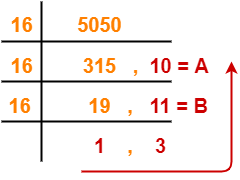
From here, (5050)10 = (13BA)16
Thus, (11672)8 = (13BA)16
Problem-03:
Convert (2724)8 to ( ? )5
Solution-
Step-01: Conversion To Base 10-
(2724)8 → ( ? )10
Using Expansion method, we have-
(2724)8
= 2 x 83 + 7 x 82 + 2 x 81 + 4 x 80
= 1024 + 448 + 16 + 4
= (1492)10
From here, (2724)8 = (1492)10
Step-02: Conversion To Base 5-
(1492)10 → ( ? )5
Using Division method, we have-
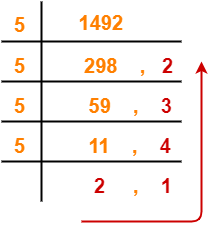
From here, (1492)10 = (21432)5
Thus, (2724)8 = (21432)5
Problem-04:
Convert (3211)4 to ( ? )5
Solution-
Step-01: Conversion To Base 10-
(3211)4 → ( ? )10
Using Expansion method, we have-
(3211)4
= 3 x 43 + 2 x 42 + 1 x 41 + 1 x 40
= 192 + 32 + 4 + 1
= (229)10
From here, (3211)4 = (229)10
Step-02: Conversion To Base 5-
(229)10 → ( ? )5
Using Division method, we have-
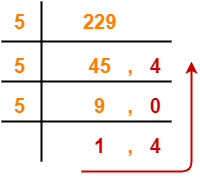
From here, (229)10 = (1404)5
Thus, (3211)4 = (1404)5
Problem-05:
Convert (1001001100)2 to ( ? )6
Solution-
Step-01: Conversion To Base 10-
(1001001100)2 → ( ? )10
Using Expansion method, we have-
(1001001100)2
= 1 x 29 + 0 x 28 + 0 x 27 + 1 x 26 + 0 x 25 + 0 x 24 + 1 x 23 + 1 x 22 + 0 x 21 + 0 x 20
= 512 + 64 + 8 + 4
= (588)10
From here, (1001001100)2 = (588)10
Step-02: Conversion To Base 6-
(588)10 → ( ? )6
Using Division method, we have-
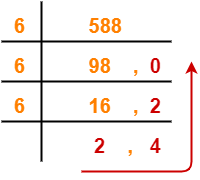
From here, (588)10 = (2420)6
Thus, (1001001100)2 = (2420)6
To gain better understanding about Conversion of Bases,
Get more notes and other study material of Number System.
Watch video lectures by visiting our YouTube channel LearnVidFun.

